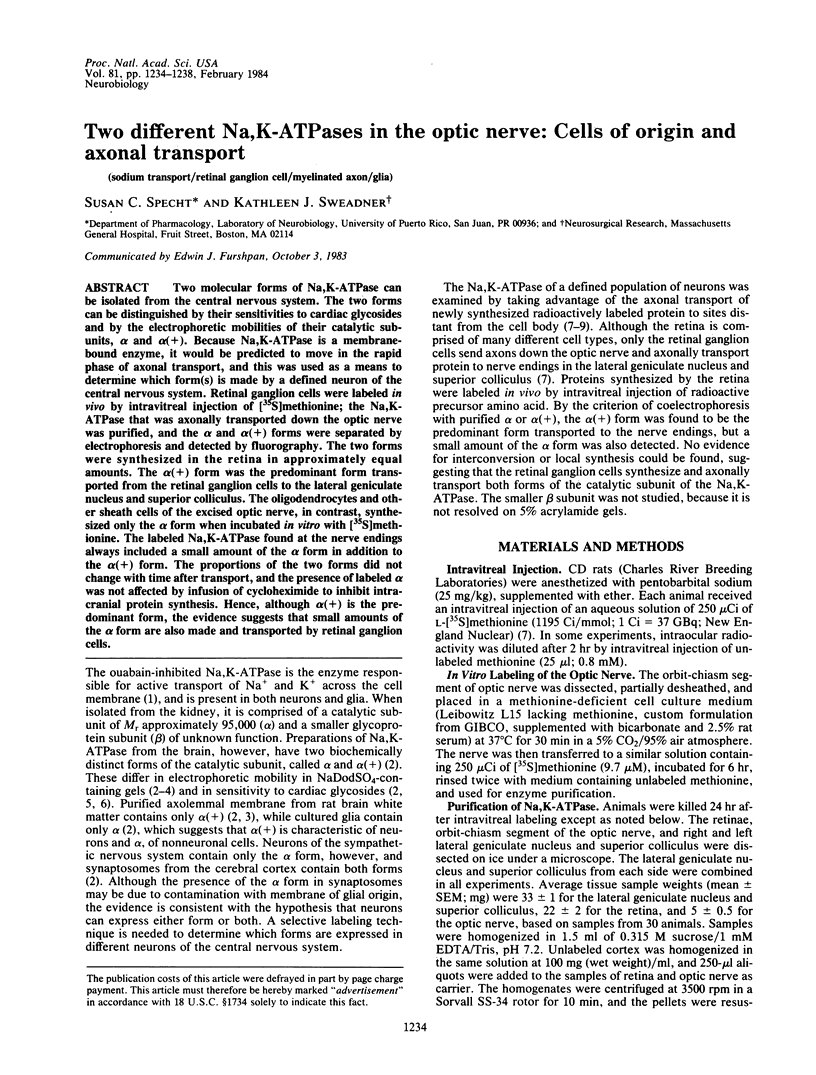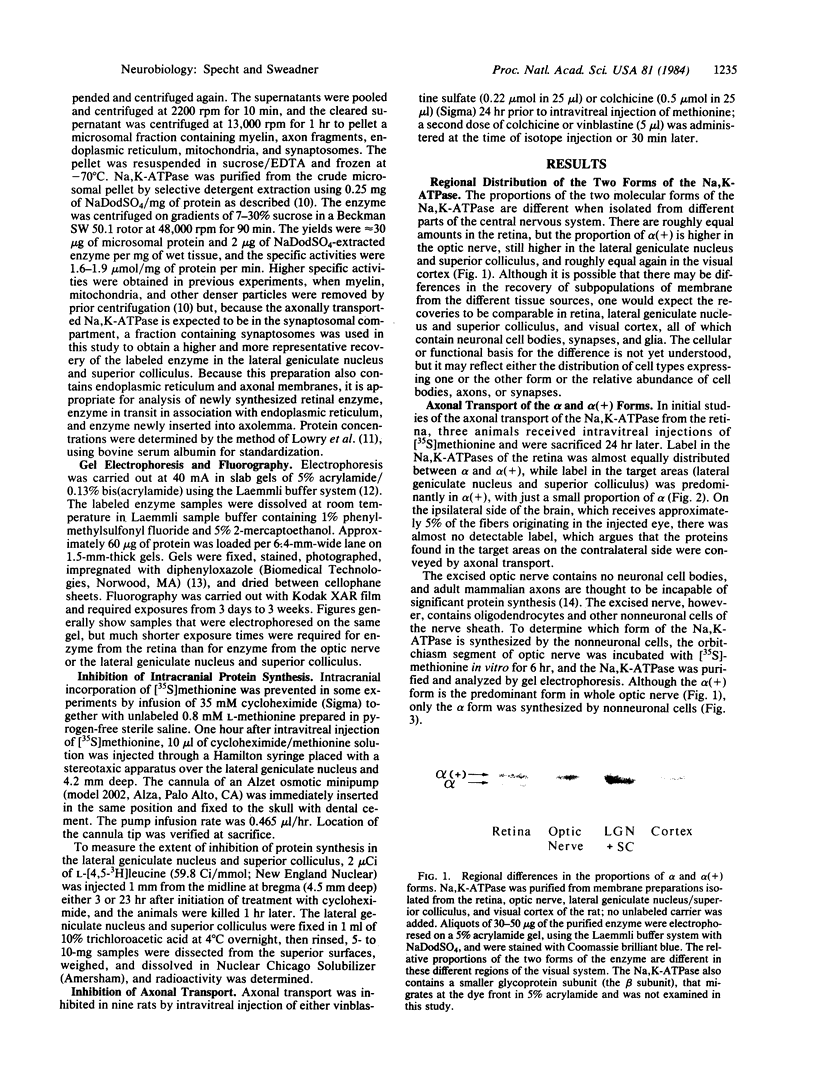Abstract
Two molecular forms of Na,K-ATPase can be isolated from the central nervous system. The two forms can be distinguished by their sensitivities to cardiac glycosides and by the electrophoretic mobilities of their catalytic subunits, alpha and alpha(+). Because Na,K-ATPase is a membrane-bound enzyme, it would be predicted to move in the rapid phase of axonal transport, and this was used as a means to determine which form(s) is made by a defined neuron of the central nervous system. Retinal ganglion cells were labeled in vivo by intravitreal injection of [35S]methionine; the Na,K-ATPase that was axonally transported down the optic nerve was purified, and the alpha and alpha(+) forms were separated by electrophoresis and detected by fluorography. The two forms were synthesized in the retina in approximately equal amounts. The alpha(+) form was the predominant form transported from the retinal ganglion cells to the lateral geniculate nucleus and superior colliculus. The oligodendrocytes and other sheath cells of the excised optic nerve, in contrast, synthesized only the alpha form when incubated in vitro with [35S]methionine. The labeled Na,K-ATPase found at the nerve endings always included a small amount of the alpha form in addition to the alpha(+) form. The proportions of the two forms did not change with time after transport, and the presence of labeled alpha was not affected by infusion of cycloheximide to inhibit intracranial protein synthesis. Hence, although alpha(+) is the predominant form, the evidence suggests that small amounts of the alpha form are also made and transported by retinal ganglion cells.
Full text
PDF




Images in this article
Selected References
These references are in PubMed. This may not be the complete list of references from this article.
- Ambron R. T., Treistman S. N. Glycoproteins are modified in the axon of R2, the giant neuron of Aplysia californica, after intra-axonal injection of [3H]N-acetylgalactosamine. Brain Res. 1977 Feb;121(2):287–309. doi: 10.1016/0006-8993(77)90153-6. [DOI] [PubMed] [Google Scholar]
- Bonner W. M., Laskey R. A. A film detection method for tritium-labelled proteins and nucleic acids in polyacrylamide gels. Eur J Biochem. 1974 Jul 1;46(1):83–88. doi: 10.1111/j.1432-1033.1974.tb03599.x. [DOI] [PubMed] [Google Scholar]
- Brown B. A., Nixon R. A., Marotta C. A. Posttranslational processing of alpha-tubulin during axoplasmic transport in CNS axons. J Cell Biol. 1982 Jul;94(1):159–164. doi: 10.1083/jcb.94.1.159. [DOI] [PMC free article] [PubMed] [Google Scholar]
- Chihara E. Axoplasmic and nonaxoplasmic transport along the optic pathway of albino rabbits; a theoretical pattern of distribution. Invest Ophthalmol Vis Sci. 1979 Apr;18(4):339–345. [PubMed] [Google Scholar]
- Droz B., Koenig H. L., Biamberardino L. D., Di Giamberardino L. Axonal migration of protein and glycoprotein to nerve endings. I. Radioautographic analysis of the renewal of protein in nerve endings of chicken ciliary ganglion after intracerebral injection of (3H)lysine. Brain Res. 1973 Sep 28;60(1):93–127. doi: 10.1016/0006-8993(73)90852-4. [DOI] [PubMed] [Google Scholar]
- Dräger U. C. Autoradiography of tritiated proline and fucose transported transneuronally from the eye to the visual cortex in pigmented and albino mice. Brain Res. 1974 Dec 27;82(2):284–292. doi: 10.1016/0006-8993(74)90607-6. [DOI] [PubMed] [Google Scholar]
- Gainer H., Sarne Y., Brownstein M. J. Neurophysin biosynthesis: conversion of a putative precursor during axonal transport. Science. 1977 Mar 25;195(4284):1354–1356. doi: 10.1126/science.65791. [DOI] [PubMed] [Google Scholar]
- Grafstein B. Transneuronal transfer of radioactivity in the central nervous system. Science. 1971 Apr 9;172(3979):177–179. doi: 10.1126/science.172.3979.177. [DOI] [PubMed] [Google Scholar]
- Grafstein B. Transport of protein by goldfish optic nerve fibers. Science. 1967 Jul 14;157(3785):196–198. doi: 10.1126/science.157.3785.196. [DOI] [PubMed] [Google Scholar]
- Haley J. E., Wisniewski H. M., Ledeen R. W. Extra-axonal diffusion in the rabbit optic system: a caution in axonal transport studies. Brain Res. 1979 Dec 21;179(1):69–76. doi: 10.1016/0006-8993(79)90490-6. [DOI] [PubMed] [Google Scholar]
- Heacock A. M., Agranoff B. W. Reutilization of precursor following axonal transport of [3H]proline-labeled protein. Brain Res. 1977 Feb 18;122(2):243–254. doi: 10.1016/0006-8993(77)90292-x. [DOI] [PubMed] [Google Scholar]
- LOWRY O. H., ROSEBROUGH N. J., FARR A. L., RANDALL R. J. Protein measurement with the Folin phenol reagent. J Biol Chem. 1951 Nov;193(1):265–275. [PubMed] [Google Scholar]
- Laemmli U. K. Cleavage of structural proteins during the assembly of the head of bacteriophage T4. Nature. 1970 Aug 15;227(5259):680–685. doi: 10.1038/227680a0. [DOI] [PubMed] [Google Scholar]
- Lasek R. J., Tytell M. A. Macromolecular transfer from glia to the axon. J Exp Biol. 1981 Dec;95:153–165. doi: 10.1242/jeb.95.1.153. [DOI] [PubMed] [Google Scholar]
- LeVay S., Stryker M. P., Shatz C. J. Ocular dominance columns and their development in layer IV of the cat's visual cortex: a quantitative study. J Comp Neurol. 1978 May 1;179(1):223–244. doi: 10.1002/cne.901790113. [DOI] [PubMed] [Google Scholar]
- Lorenz T., Willard M. Subcellular fractionation of intra-axonally transport polypeptides in the rabbit visual system. Proc Natl Acad Sci U S A. 1978 Jan;75(1):505–509. doi: 10.1073/pnas.75.1.505. [DOI] [PMC free article] [PubMed] [Google Scholar]
- Marks M. J., Seeds N. W. Ouabain-ATPase interaction in brain cells maintained as reaggregates or surface cultures. Life Sci. 1978 Dec 31;23(27-28):2745–2755. doi: 10.1016/0024-3205(78)90655-0. [DOI] [PubMed] [Google Scholar]
- Monticone R. E., Elam J. S. Isolation of axonally transported glycoproteins with goldfish visual system myelin. Brain Res. 1975 Dec 12;100(1):61–71. doi: 10.1016/0006-8993(75)90241-3. [DOI] [PubMed] [Google Scholar]
- Nixon R. A., Brown B. A., Marotta C. A. Posttranslational modification of a neurofilament protein during axoplasmic transport: implications for regional specialization of CNS axons. J Cell Biol. 1982 Jul;94(1):150–158. doi: 10.1083/jcb.94.1.150. [DOI] [PMC free article] [PubMed] [Google Scholar]
- Paulson J. C., McClure W. O. Inhibition of axoplasmic transport by mescaline and other trimethoxyphenylalkylamines. Mol Pharmacol. 1973 Jan;9(1):41–50. [PubMed] [Google Scholar]
- Petrali E. H., Sulakhe P. V. Isolation of a plasma membrane fraction highly enriched in ouabain-sensitive Na+-K+-ATPase from rat brain white matter. Int J Biochem. 1980;12(3):407–420. doi: 10.1016/0020-711x(80)90121-4. [DOI] [PubMed] [Google Scholar]
- Quigley H. A., Guy J., Anderson D. R. Blockade of rapid axonal transport. Effect of intraocular pressure elevation in primate optic nerve. Arch Ophthalmol. 1979 Mar;97(3):525–531. doi: 10.1001/archopht.1979.01020010269018. [DOI] [PubMed] [Google Scholar]
- Schellenberg G. D., Pech I. V., Stahl W. L. Immunoreactivity of subunits of the (Na+ + K+)-ATPase. Cross-reactivity of the alpha, alpha + and beta forms in different organs and species. Biochim Biophys Acta. 1981 Dec 21;649(3):691–700. doi: 10.1016/0005-2736(81)90173-5. [DOI] [PubMed] [Google Scholar]
- Specht S. C. Transneuronal transfer of radioactive substances during postnatal development of the hamster visual system. Exp Neurol. 1980 Aug;69(2):213–224. doi: 10.1016/0014-4886(80)90205-8. [DOI] [PubMed] [Google Scholar]
- Specht S., Grafstein B. Accumulation of radioactive protein in mouse cerebral cortex after injection of 3H-fucose into the eye. Exp Neurol. 1973 Dec;41(3):705–722. doi: 10.1016/0014-4886(73)90062-9. [DOI] [PubMed] [Google Scholar]
- Sweadner K. J. Purification from brain of an intrinsic membrane protein fraction enriched in (Na+ + K+)-ATPase. Biochim Biophys Acta. 1978 Apr 20;508(3):486–499. doi: 10.1016/0005-2736(78)90094-9. [DOI] [PubMed] [Google Scholar]
- Sweadner K. J. Two molecular forms of (Na+ + K+)-stimulated ATPase in brain. Separation, and difference in affinity for strophanthidin. J Biol Chem. 1979 Jul 10;254(13):6060–6067. [PubMed] [Google Scholar]
- Urayama O., Nakao M. Organ secificity of rat sodium- and potassium-activated adenosine triphosphatase. J Biochem. 1979 Nov;86(5):1371–1381. doi: 10.1093/oxfordjournals.jbchem.a132654. [DOI] [PubMed] [Google Scholar]







